58 Small or Dwarf Flowering Shrubs With Pictures For Easy Identification
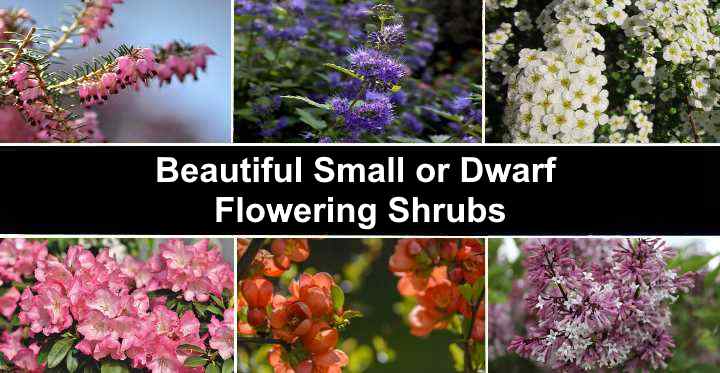
Dwarf or small flowering shrubs are ideal for compact gardens, colorful foundation planting, or to enhance large flowering bushes. Some varieties of miniature flowering shrubs are evergreen plants. So, apart from producing flowers in spring and summer, these small shrubs stay green all year long. Combinations of low-growing flowering shrubs and evergreen bushes at the front of the house can significantly enhance curb appeal.
Some of the best small flowering bushes are dwarf rhododendrons, small honeysuckle shrubs, miniature spirea plants, compact hydrangea shrubs, and small flowering potentilla shrubs.
Small or dwarf shrubs can have flowers in different colors, such as shades of pink, lilac, yellow, blue, orange, white, and red. If you plant small, colorful shrubs in flower beds and along borders and driveways, you can have a colorful garden throughout the year.
This article is a guide for choosing the best ornamental small or dwarf flowering shrubs for your front or backyard. Descriptions of small bushes with their picture and name can help you determine the best ones for your garden landscape.
What Are Dwarf Flowering Shrubs?
Dwarf flowering shrubs and low-growing bushes are plants that grow to between one and three feet (up to one meter) tall. Some varieties of bushy garden plants don’t grow very tall and are ideal for planting under windows. For other species of colorful dwarf shrubs, you must find small or miniature cultivars of larger varieties.
Small, blooming shrubs are larger and more compact than ground cover plants. Dwarf shrub varieties have upright growth rather than spreading across the ground. Most ground cover plant species grow less than 1 ft. (30 cm) tall. However, the flowering shrubs on this list grow to between 2 and 3 ft. (0.6 – 1 m) high.
Related reading: The best ground cover plants for shade.
The Benefits of Small Flowering Shrubs
Growing small, colorful shrubs in your garden landscape usually requires little care. Low-maintenance, compact shrubs don’t require regular pruning to control their growth. Generally, you don’t need to bother with deadheading, trimming, or spending time caring for small flowering bushes.
Miniature shrubs are the perfect landscaping solution for small residential gardens. You can plant short bushes along borders, in mixed flower beds, or as colorful foundation plants. You can even plant small shrubs that flower in containers to brighten up a patio, deck area, or balcony.
Another benefit of small ornamental shrubs is that they add year-round seasonal interest to your landscape, providing color and scent to your garden, while also attracting pollinators and wildlife.
How to Pick the Best Small Flowering Shrub for Your Garden
Picking the perfect small flowering shrub for your front or backyard enhances your garden’s aesthetics. To choose the right types of low-growing shrubs, consider how much direct sunlight the plants need and your USDA hardiness zone. It would be best if you also think about each shrub’s soil requirements and watering needs.
It’s good to remember that your growing zone significantly affects your choice of dwarf shrubs. Some low-growing flowering perennial shrubs only grow as annuals in cold climates. Also, certain small flowering shrub varieties need full sun or partial shade to thrive, whereas other miniature shrubs grow well in full shade.
Most small flowering shrubs grow to between 1 and 3 ft. (0.3 – 1 m). So, it’s also a good idea to consider the other plants growing nearby. For example, large trees or bushes could create constant shade for a sun-loving dwarf shrub.
Small or Dwarf Flowering Shrubs With Their Picture and Name – Identification Guide
Here are some of the best dwarf or small flowering shrubs for the front of your house or backyard.
Dwarf Japanese Pieris Shrub (Pieris japonica ‘Cavatine’)
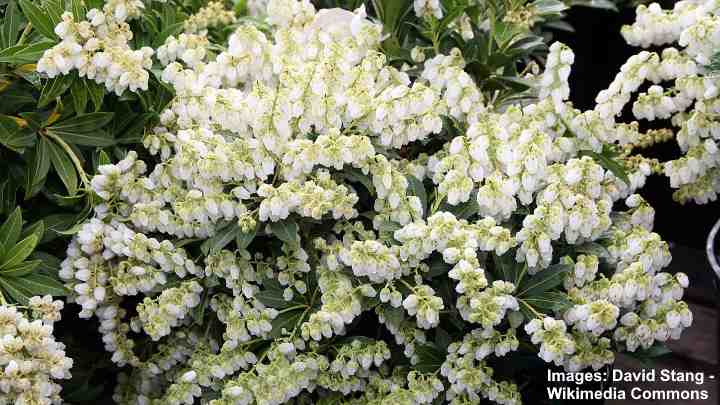
The small-flowering Pieris japonica ‘Cavatine’ shrub looks beautiful in any front or backyard
The Japanese Pieris ‘Cavatine’ is a compact evergreen flowering shrub that showcases pinkish-white bell-shaped flowers in early spring. This short evergreen shrub doesn’t grow taller than 2 ft. (0.6 m) tall which makes it an excellent choice for small gardens and landscapes. The Japanese Pieris ‘Cavatine’ is a low-maintenance small shrub that produces spectacular displays of creamy-white clusters of flowers in drooping panicles. The small, rounded bush has dark-green, leathery leaves.
Other common names for the small Japanese Pieris shrub are Japanese andromeda and dwarf lily-of-the-valley shrub.
You can grow the compact shrubby Japanese Pieris plant in full sun or partial shade in USDA zones 5 to 8. Dwarf Japanese Pieris shrubs are ideal for flower beds, informal rock gardens, low-growing hedges, and flowering borders.
- USDA Zones: 5 to 8
- Size: 2 ft. (0.6 m) tall
- Light Exposure: Full sun to partial shade with afternoon shade
- Soil: Organically rich, moist, well-drained soil
Dwarf Rhododendron Flowering Shrubs

Dwarf rhododendron bushes ‘Hino Crimson’ (left image) with pink flowers, and ‘Ramapo’ (right image) with stunning, colorful purple flowers
Miniature rhododendron shrubs produce masses of spectacular pastel-colored flowers every spring. Rhododendrons are hardy, low-maintenance woody shrubs, and the dwarf cultivars don’t grow higher than 3 ft. (1 m). The small, compact rhododendron shrubs are perfect flowering plants for the front yard, small gardens, containers, mixed beds, foundation plants, and driveway borders.
Evergreen flowering rhododendron shrubs thrive in full sun or partial shade. Small flowering shrubs in the Rhododendron family thrive in zones 5 to 8.
Here are some excellent flowering dwarf rhododendron shrubs for your front or backyard:
Rhododendron ‘Hino Crimson’

Rhododendron ‘Hino Crimson’ is a small evergreen flowering shrub that doesn’t grow taller than 3 ft. (1 m). It is known for its highly attractive, red trumpet-shaped flowers. The plant also features shiny, dark-green, elliptical leaves. The low-growing, colorful bush is ideal for planting at the front of the house or as a small flowering hedgerow.
Rhododendron ‘Ramapo’
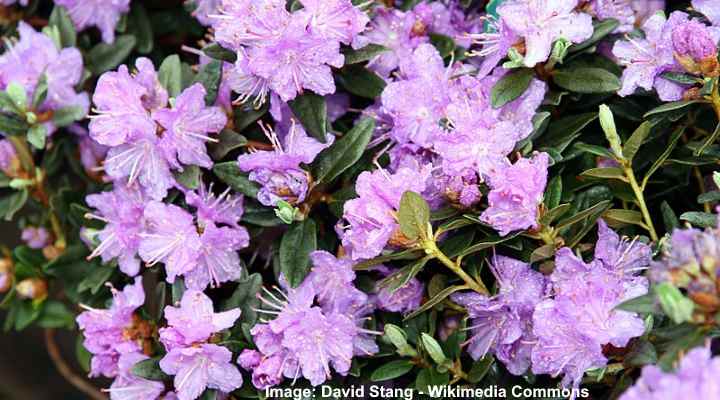
Rhododendron ‘Ramapo’
Beautiful, cold-hardy small shrub that produces stunning clusters of purple or lilac flowers. Grow this evergreen flowering shrub in full sun in zones 4 to 8. The ‘Ramapo’ cultivar has more compact growth in small, shaded gardens. Additionally, this plant is tough, capable of withstanding temperatures as low as -25°F (-32°C).
Rhododendron ‘Ginny Gee’ – A miniature flowering shrub that grows between 1 and 2 ft. (0.3 – 0.6 m) tall. Pink and rose-colored blooms appear in spring and cover the whole shrub in beautiful flowers.
- USDA Zones: 5 to 8
- Size: 3 ft. (1 m) tall
- Light Exposure: Full sun to partial shade
- Soil: Organically rich, well-drained soil
Small Cotoneaster Flowering Shrubs
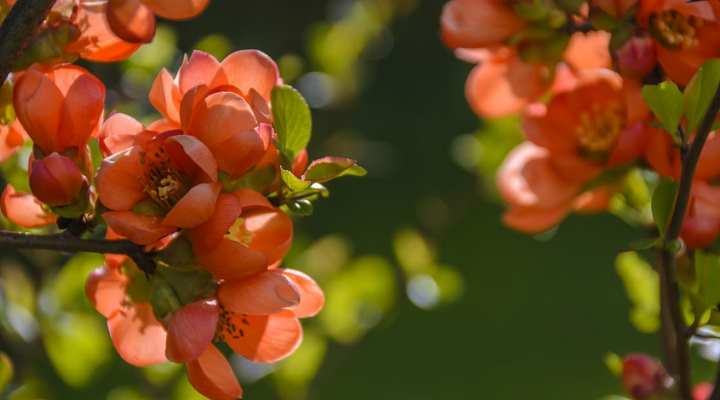
The small flowering cotoneaster shrubs are easy to care for and are low-maintenance
Dwarf cotoneaster shrubs are woody plants with small oval leaves and pink or white flowers. Small varieties of cotoneaster shrubs grow to between 1 and 3 ft. (0.3 – 1 m) and have stiff branches that create sprays of foliage. The small pink or white flowers give way to red berries that look attractive against the green foliage in the fall.
Most species of cotoneaster—dwarf and full-grown—thrive in full sun or partial shade. These hardy landscaping bushes are ideal for compact gardens to provide low-growing edging, ground cover for full sun, or growing in beds or borders.
The blooming period for this plant ranges from late spring to early summer.
Most cotoneaster shrub varieties are hardy in USDA zones 5 to 8.
- USDA Zones: 5 to 8
- Size: 1 to 3 ft. (0.3 – 1 m) tall
- Light Exposure: Full sun
- Soil: Moist, well-drained soil
Small Flowering Potentilla Shrubs (Potentilla fruticosa)

Potentilla fruticosa (in the picture) grows up to 3.2 ft. (1 m tall) and has pretty yellow flowers
Potentilla bushes produce masses of colorful flowers that bloom for a long time. Potentilla is a deciduous shrub species, with many cultivars not growing taller than 3 ft. (1 m). The dainty, pastel-colored flowers bloom throughout the summer, from late spring until frost. The small shrubby plants are best grown in full or partial sun.
Potentilla bushes bloom all summer long, and they are great for growing in beds or borders or planting as a low-growing flowering hedge. The masses of yellow, white, pink, red, and orange flowers contrast with the dark-green foliage of small oval leaves. Small potentilla flowering shrubs are perfect for beds and borders or as colorful foundation shrubs under your windows.
Dwarf potentilla shrubs flower and thrive in zone 3 to 7.
- USDA Zones: 3 to 7
- Size: 3 ft. (1 m) tall
- Light Exposure: Full to partial sun
- Soil: Moist, fertile, well-drained soil
Dwarf Spirea Shrubs (Spiraea)
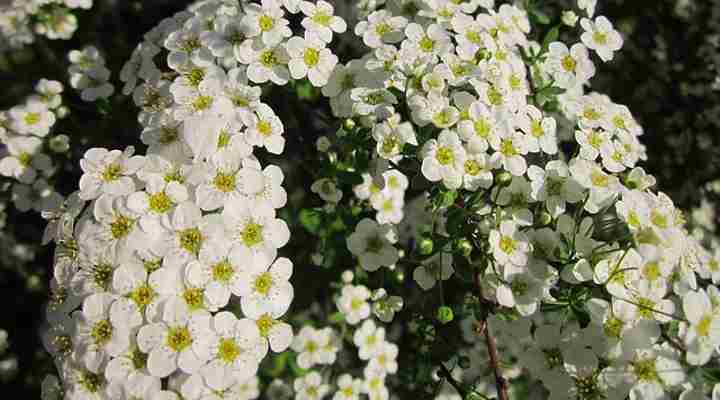
The stunning flowers of the dwarf spirea shrub make it perfect for front of house landscaping
Spirea shrubs are easy-care, small flowering shrubs with clusters of flowers and stunning foliage. Spirea flowers bloom in spring or summer and can be red, rosy-pink, white, or blue. Many spirea species are low-growing shrubby plants that thrive in full sun. Spirea deciduous shrubs have foliage that turns spectacular oranges, reds, yellows, and purples in the fall.
Dwarf spirea shrubs grow up to 3 ft. (1 m) tall. The small flowering bushes grow best as foundation plants, border plants, or flowering pathway edging. You can also plant the shrubs in containers to grow on porches or balconies. Spirea shrubs thrive in zones 3 to 8.
- USDA Zones: 3 to 8
- Size: 3 ft. (1 m) tall
- Light Exposure: Full sun
- Soil: Fertile, well-drained soil
Japanese Skimmias (Skimmia Japonica)
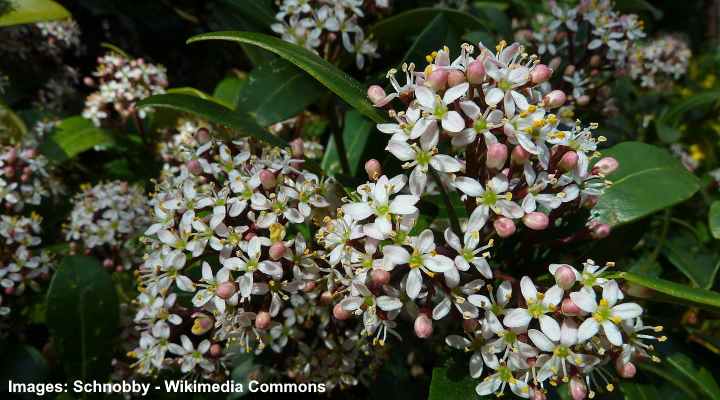
Skimmia Japonica is a small, flowering evergreen shrub that is easy to care for and loves shade
The Japanese Skimmia is an evergreen dwarf flowering shrub that thrives in the shade. This low-growing, spring-blooming shrub grows to 4 ft. (1.2 m) with a domed shape. Japanese skimmia shrubs are known for their fragrant, star-shaped flowers, evergreen foliage with lanceolate leaves, and bright red berries.
It’s best to grow short Japanese Skimmias in flowering shrub borders, as low-maintenance foundation plantings, blooming hedges, or patio containers. Grow these shade-loving evergreen flowering bushes in zones 6 to 8 for the best results.
Japanese Skimmia is on the list of the best small or dwarf evergreen shrubs.
- USDA Zones: 6 to 8
- Size: 4 ft. (1.2 m) tall
- Light Exposure: Shade to dappled sunlight
- Soil: Moist, organically rich, well-drained soil
Winter Heath (Erica carnea)
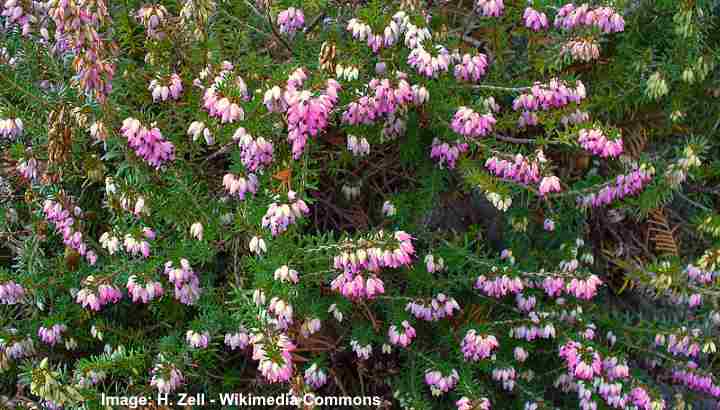
The ornamental small winter heath shrub is grown for its evergreen foliage and purple flowers
The winter heath is a stunning, low-growing flowering plant that flowers in early spring. The spectacular feature of winter heath is its masses of flowers, which can have colors such as purple, pink, and magenta. Winter heath has flowers that bloom for many weeks during the winter and early spring. Grow the short shrub as a flowering ground cover plant, container plant, or for adding winter color to mixed beds.
Winter heath grows up to 1 ft. (0.3 m) tall. The colorful miniature bushes need to grow in full sun in zones 5 to 8 to thrive. Other names for the compact, spreading wither heath shrub are December Red, winter-flowering heath, and alpine heath.
- USDA Zones: 5 to 8
- Size: 1 ft. (0.3 m) tall
- Light Exposure: Full sun
- Soil: Sandy, acidic, well-drained soil
Bluebeard (Caryopteris x clandonensis)
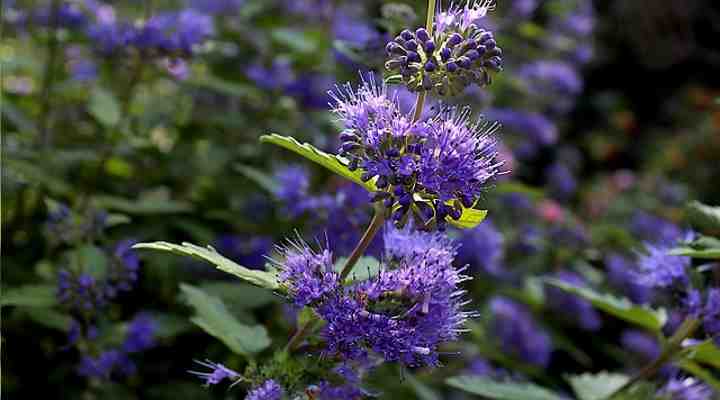
The small bluebeard shrub has purple or blue flowers that can add a decorative touch to a frontyard
The bluebeard is one of the few small flowering shrubs that starts blooming in late summer. The flowers of this small deciduous shrub are blue or purple. Some varieties of bluebeard have dark to light-green foliage, and others have variegated ovate-shaped leaves. Bluebeard is an easy-care shrub that grows best in perennial borders or flower beds.
Small bluebeard bushy shrubs grow to between 2 and 3 ft. (0.6 – 1 m) in zones 5 – 9. The shrub stems grow upward and outward to give the plant a rounded shape. Bluebeard is an ornamental plant that is ideal for compact residential landscapes.
- USDA Zones: 5 to 9
- Size: 2 to 3 ft. (0.6 – 1 m) tall
- Light Exposure: Full sun
- Soil: Well-drained soil
Virginia Sweetspire (Itea virginica)
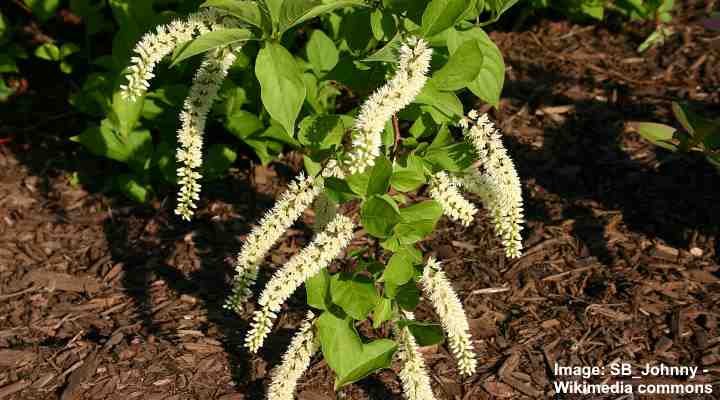
The low-growing sweetspire shrub is great for landscaping compact spaces
Also called the Virginia willow, some varieties of sweetspire are dwarf shrubs with white flowers growing in spikes. In late spring to early summer, the bottlebrush flowers almost cover the short, rounded shrub. This sun-loving landscaping shrub grows up to 3 ft. (1 m) tall and doesn’t require any maintenance.
The dwarf sweetspire cultivars are called ‘Little Henry.’ The low-growing shrubby plant is ideal for the front of the house to boost curb appeal. And it grows just as well in full sun as it does in the shade. Grow Virginia sweetspire as flowering ground cover, blooming hedges, or to brighten up a shrub border.
Sweetspire shrubs are hardy in USDA zones 5-9.
Japanese Skimmia is on the list of the best low-maintenance plants.
- USDA Zones: 5 to 9
- Size: 3 ft. (1 m) tall
- Light Exposure: Full sun to full shade
- Soil: Moist, well-drained, humus-rich soil
Hummingbird Summersweet (Clethra alnifolia)
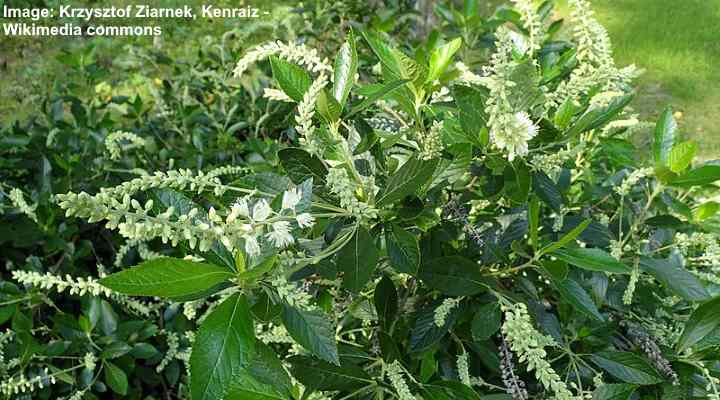
Clethra alnifolia ‘Hummingbird’ is a compact shrub that is suitable for both sunny and shady locations
The summersweet cultivar ‘Hummingbird’ is a small flowering bush with bottlebrush-like, fragrant white flowers. Summersweet shrubs flower from mid to late summer, and the blossoms can last for up to six weeks. This shrub is a compact cultivar ideal for shaded gardens, mixed beds, or flowering shrub borders.
Summersweet shrubs have year-round interest. Beautiful blooms appear in summer that develop into brown fruits that last until winter. In the fall, the glossy dark-green foliage turns a warm yellow. Summersweet is an ideal flowering shrub for growing in the shade or full sun.
Grow summersweet in zones 3 to 9.
- USDA Zones: 3 to 9
- Size: 3 to 6 ft. (0.9 – 1.8 m) tall
- Light Exposure: Full sun to partial shade
- Soil: Moist, well-drained soil
Butterfly Bush (Buddleja)

The short butterfly bush has attractive flowers that attract butterflies to your garden
The fragrant flowers on low-growing butterfly bushes do as their name suggests—attract butterflies. Butterfly bush flowers are long, colorful panicles that come in shades of purple, lilac, orange, pink, white, and magenta. The stunning ornamental flower spikes last from summer through to the first frost.
The dwarf butterfly bush varieties grow between 1 and 3 ft. (0.3 – 1 m) tall. The small shrubs have a rounded growth habit and lance-shaped green leaves. The butterfly bush’s compact growth makes it ideal for growing in small gardens with limited space.
Butterfly bushes thrive in zones 5 to 9.
- USDA Zones: 5 to 9
- Size: 1 to 3 ft. (0.3 – 1 m) tall
- Light Exposure: Full sun
- Soil: Well-drained soil
Dwarf Blue Honeysuckle Shrubs (Lonicera caerulea, Lonicera xylosteum)
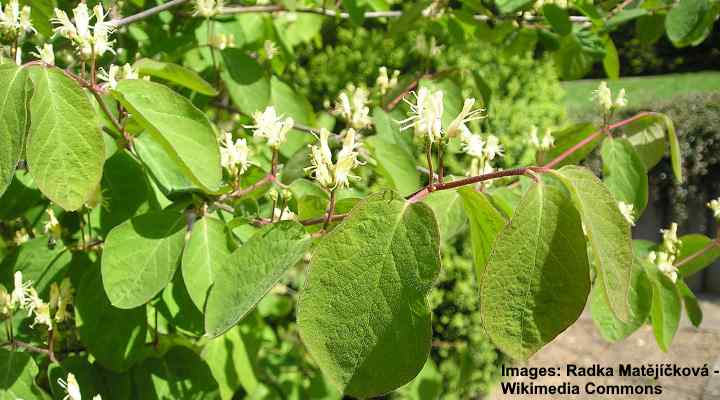
Lonicera xylosteum (in the picture) is a low-growing shrub with fragrant flowers
A few honeysuckle shrubs are flowering dwarf plants with compact growth. The ‘Blue Moon’ and ‘Borealis’ honeyberry, or blue honeysuckle, are cold-hardy deciduous shrubs that grow up to 3 ft. (1 m) tall. The blue honeysuckle shrub has yellowish-white flowers that develop into edible blue, blueberry-like fruits.
The honeysuckle species Lonicera xylosteum is a type of compact dwarf honeysuckle that more closely resembles climbing perennial honeysuckles with their scented flowers. Unlike blue honeysuckle, you shouldn’t eat the fruits of regular honeysuckle plants.
Both of these varieties bloom innclude growing it as a late spring until early summer.
- USDA Zones: 4 to 6
- Size: Up to 8 ft. (2.4 m) tall – depending on variety
- Light Exposure: Full sun to partial shade
- Soil: Well-drained soil
Small Hydrangea Shrubs (Hydrangea macrophylla)

Choose a small variety of hydrangea as a front of house accent flowering plant
Several species of hydrangea have compact, short growth, which makes them ideal flowers for small gardens. Hydrangeas are deciduous landscaping shrubs with a rounded shape and clusters of large, globular flowers. Hydrangea flowers appear in summer and bloom for many weeks. The dwarf shrub varieties are ideal for growing where yard space is limited.
Flowering dwarf hydrangeas grow best as low hedges, low-maintenance foundation plants, accent plants, or container plantings. Planting a few short hydrangea shrubs at the front of your house will add bright red, pink, and white flowers to your front yard landscape.
Small hydrangeas flower profusely in summer in zones 6 to 9, with some cultivars also being cold hardy to zone 5.
- USDA Zones: 5 to 9
- Size: 4 to 5 ft. (1.2 – 1.5 m) tall
- Light Exposure: Most hydrangeas require some morning sun and afternoon shade to thrive and flower, although a few are shade lovers
- Soil: Organically rich, moist, well-drained soil
Dwarf Fothergilla (Fothergilla gardenii)
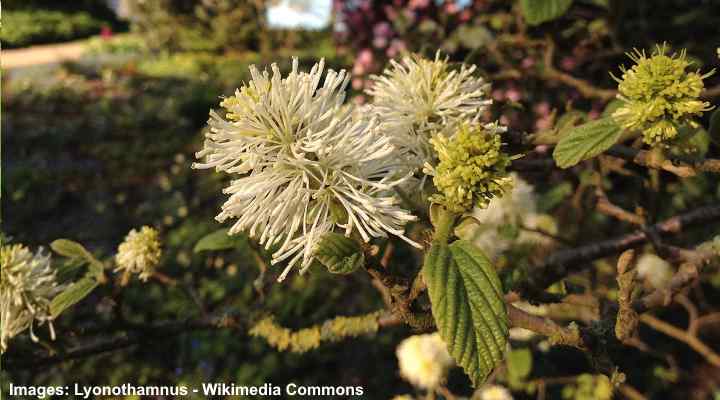
The dwarf Fothergilla flowering shrub can grow in full sun or partial shade
The dwarf fothergilla is an ornamental bushy flowering shrub with dense, compact growth. The low-growing native shrub transforms in spring when white bottlebrush-like flowers appear. The spiky shrub flowers have sweet honey scents and appear before the green leaves appear. In the fall, dwarf fothergilla becomes a compact shrub of warm yellow, red, and orange hues.
The dwarf fothergilla grows to between 2 and 3 ft. (0.6 – 1 m) tall. The short-flowering shrub grows best in shrub borders, compact gardens, along foundations, or to line a path or driveway. This slow-growing small shrub thrives in zones 5 to 8.
Another common name for dwarf fothergilla (Fothergilla gardenii) is dwarf witch alder.
- USDA Zones: 5 to 8
- Size: 2 to 3 ft. (0.6 – 1 m) tall
- Light Exposure: Full sun
- Soil: Moist, well-drained soil
Wine Ninebark (Physocarpus opulifolius)
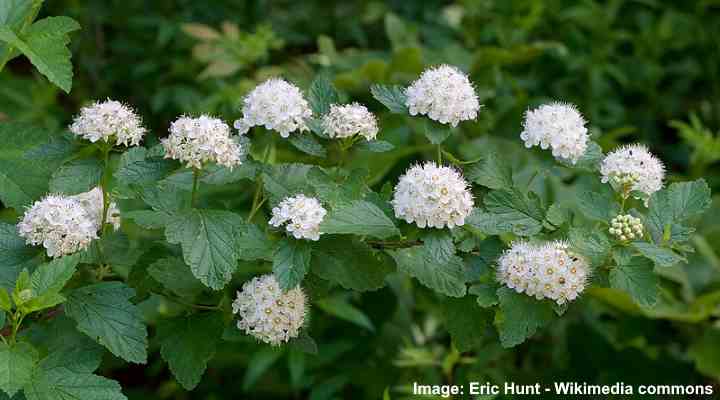
The compact growth of the dwarf ninebark shrub is great in rock gardens or at the front of flower beds
The ninebark is a small native flowering shrub that has showy white or pink flowers. The blooms on ninebark dwarf shrubs grow as clusters of dense flowers that form a flat, rounded flowerhead. The white flowers in springtime contrast with the round leaves that have three to five lobes.
The ninebark cultivar ‘Nanus’ is the dwarf variety of this deciduous shrub. The small, compact shrub has dense branches but foliage and flowers similar to those of the larger species. Grow this little shrub in flowering borders, as a small hedge, or to add showy flowers to a rock garden.
Ninebark ‘Nanus’ is cold-hardy in zones 2 to 8.
- USDA Zones: 2 to 8
- Size: 5 to 8 ft. (1.5 – 2.4 m) tall
- Light Exposure: Full sun
- Soil: Moist, well-drained soil
Lavender (Lavandula)

Grow lavender in full sun for the best results
Lavender is an attractive, low-growing shrubby plant with scented purple flowers. Lavender shrubs grow to between 1 and 3 ft. (0.3 – 1 m) tall. The small shrub has spikes of purple or lilac flowers with an easily recognizable ‘lavender’ scent. Lavender shrubs bloom throughout the summer and thrive in zones 5 to 9.
Lavender is an ideal dwarf flowering shrub for borders, informal edging, herb gardens, or mixed flower beds. Plant lavender flowers in full sun in well-drained soil for best results.
- USDA Zones: 5 to 9
- Size: 1 to 3 ft. (0.3 – 1 m) tall
- Light Exposure: Full sun
- Soil: Well-drained soil
Dwarf Blooming Lilac (Syringa)
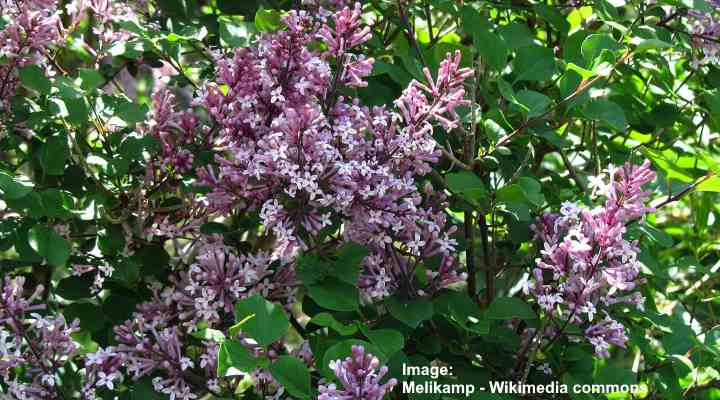
Syringa meyeri ‘Palibin’ is a dwarf Korean lilac bush for small gardens as it grows to around 4-5 ft. (1.2-1.5 m) tall
Dwarf lilac bushes are ideal flowering plants for compact spaces. Although many lilac species are large shrubs or small trees, a few cultivars only grow up to 3 ft. (1 m) high. The small shrubs have compact, rounded growth, and they produce sweetly scented clusters of pink flowers in spring.
Small lilac shrubs are ideal for front-of-house planting, mixed shrub borders, or perennial flower beds. The showy flowers and dense foliage add plenty of color and greenery to small gardens. Grow small lilac shrubs in full sun where they thrive in zones 3 to 7.
- USDA Zones: 3 to 7
- Size: 3 ft. (1 m) tall
- Light Exposure: Full sun
- Soil: Fertile, humus-rich, well-drained soil
Small Azalea Shrubs for Full Sun (Rhododendron spp.)

Flowering azalea shrubs include small cultivars that will give stunning color to any landscaped garden
Dwarf azaleas are small flowering shrubs that blossom with yellow, red, purple, and pink flowers in spring or summer. Small azalea shrubs are ideal for adding a splash of color to compact garden landscapes. The ornamental shrubs grow 2 to 6 ft. (0.6 – 1.8 m) tall and wide. The shrubs have an attractive rounded shape, showy flowers, and a deep red fall color.
Azalea shrubs are identified by their beautiful funnel-shaped or cup-shaped flowers. The star-shaped blooms can measure 2” to 3” (5 – 7.5 cm) long and are characterized by long, protruding stamens. The shrub’s leaves are thick and leathery with a deep green, glossy sheen.
Depending on the species, azaleas thrive well in full sun in USDA zones 3 to 9. The compact, bushy plants are easy to grow and require little maintenance. If you choose the dwarf varieties, they will retain their short stature and spread without pruning or maintenance.
- USDA Zones: 3 to 9
- Size: 2 to 6 ft. (0.6 – 1.8 m) tall and wide
- Light Exposure: Full sun to dappled sunlight but they typically do best with afternoon shade
- Soil: Organically rich, well-drained soil
Forsythia
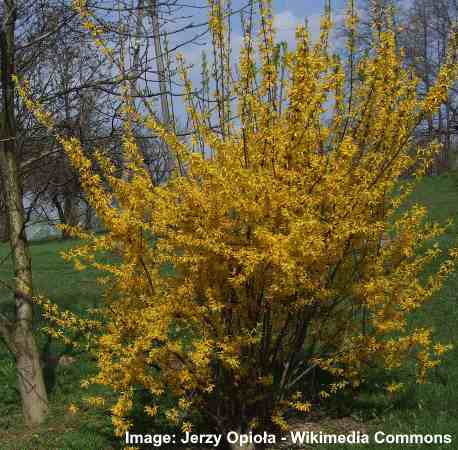
Dwarf forsythia cultivars are hardy shrubs that make a good choice for a fast-growing flowering hedge for the front of house
Forsythia is a yellow-flowering, sun-loving shrub that doesn’t grow more than a few feet tall. The masses of brightly colored yellow flowers help to brighten small gardens in late winter and early spring. In late spring and summer, dense foliage of dark green oval leaves creates an attractive bush.
The best forsythia shrub for gardens with limited space is the Forsythia ‘Happy Centennial.’ This miniature flowering shrub grows 2 to 3 ft. (0.6 – 1 m) tall and up to 5 ft. (1.5 m) wide.
Forsythia shrubs have enormous value in a landscape due to their three-season interest. The flowering shrub is ideal for foundation planting, a decorative hedge, or specimen planting. Grow in full or partial sun in USDA zones 5 to 9.
- USDA Zones: 5 to 9
- Size: 2 to 3 ft. (0.6 – 1 m) tall, 5 ft. (1.5 m) wide
- Light Exposure: Full to partial sun
- Soil: Loose, well-drained soil
Indian Hawthorn (Rhaphiolepis indica)
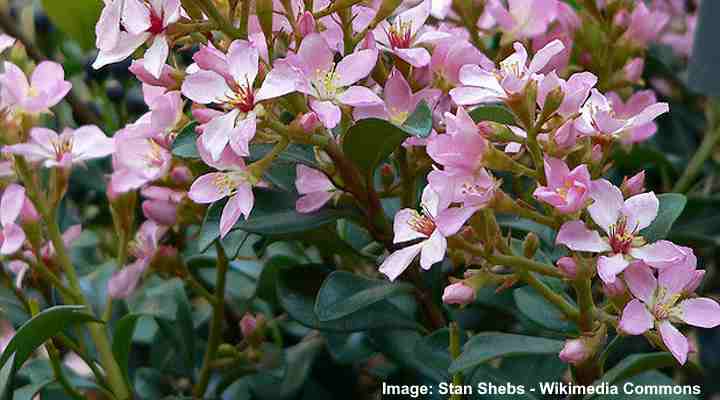
Indian hawthorn is an evergreen flowering shrub with pink or white flowers. This picture shows Rhaphiolepis indica cv. ‘Ballerina’
Indian hawthorn is a flowering evergreen shrub that blooms with masses of white and pink flowers. Not growing taller or wider than 4 to 6 ft. (1.2 – 1.8 m), this bushy plant adds a pop of year-round color in small to medium-sized yards with pinkish-white spring flowers and dark evergreen foliage.
Clusters of small, fragrant flowers are the most appealing quality of Indian hawthorn. And its leathery, lance-shaped leaves stay on the plant throughout the year. These landscaping features make the shrub ideal for planting as a privacy screen, shrub border, foundation planting, or container plant.
Grow Indian hawthorn in full sun and well-drained soil. The plant is drought-tolerant once established and is cold-hardy in USDA zones 8 through 11.
- USDA Zones: 8 to 11
- Size: 4 to 6 ft. (1.2 – 1.8 m) tall and wide
- Light Exposure: Full sun
- Soil: Well-drained soil
Small Viburnum Shrubs for Full Sun
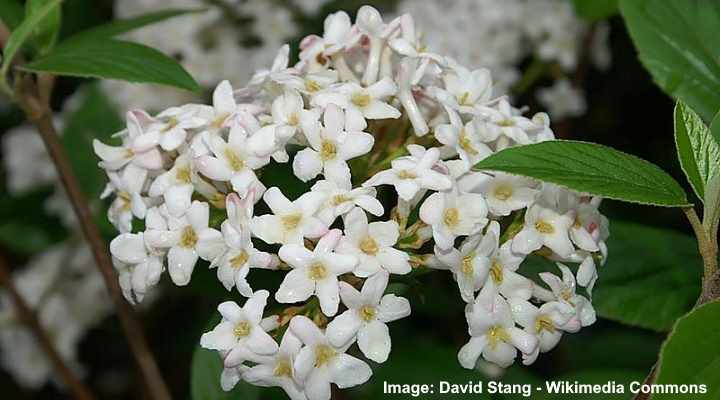
Viburnum x burkwoodii Mohawk (in the picture) is a small white flowering shrub that doesn’t grow taller than 5 ft. (1.5 m) tall
Small viburnum shrubs produce ball-like clusters of small cup-shaped or star-shaped white flowers. Dwarf viburnums grow between 1 and 5 ft. (0.3 – 1.5 m) tall and wide, making them perfect if space is limited in a garden landscape. The decorative deciduous shrubs produce sweet cinnamon fragrances as they bloom in spring and summer.
Viburnum shrubs also have broadly ovate leaves that emerge bronze, turn dark green, and then turn maroon in the fall. In fall, clusters of bright red berries appear, giving the shrub more landscaping value.
Small viburnum shrubs thrive in USDA zones 4 through 7 and perform best in full sun. You can plant the compact shrubs in perennial borders or grow them as a flowering hedge, foundation planting, or specimen plant.
- USDA Zones: 4 to 7
- Size: 1 to 5 ft. (0.3 – 1.5 m) tall
- Light Exposure: Full sun
- Soil: Moist, well-drained soil
Shrub Roses (Rosa)
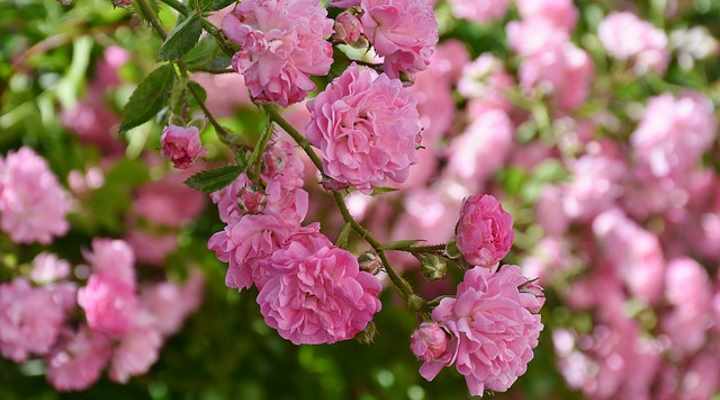
Shrub roses include many cultivars with various flower colors and shapes
Shrub roses are low-growing, bushy plants that add beautiful colors and aromas to a summer landscape. Many varieties of shrub roses grow between 1 and 4 ft. (0.3 – 1.2 m) tall and have compact growth, making them ideal for small gardens. The showy rosette flowers contrast with dark green, glossy foliage.
The colorful, fragrant flowers typically have double blooms with ruffled petals in shades of white, peach, yellow, pink, red, and purple. In addition, the beautiful rose flowers have a long blooming season, from late spring until fall.
Most varieties of shrub roses thrive in USDA zones 5 through 9. The shrubby plants perform best in full sun, growing in moist, well-drained soils. Summer pruning helps to maintain the shrub’s compact growth and encourages repeat blooming.
- USDA Zones: 5 to 9
- Size: 1 to 4 ft. (0.3 – 1.2 m) tall
- Light Exposure: Full sun
- Soil: Moist, well-drained soil
Dwarf Chenille (Acalypha Reptans)
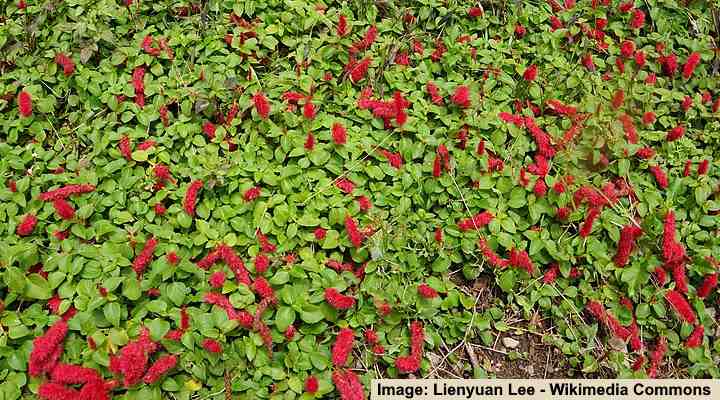
The dwarf chenille shrub is a low-growing, evergreen, flowering ground cover for full to partial sun
The dwarf chenille is a spreading evergreen shrub with spectacular fuzzy red flower spikes. The low-growing shrub is identified by its heart-shaped leaves and arching, bright red flowers that bloom sporadically. In compact gardens, you can plant dwarf chenille in containers or hanging baskets to add vibrant colors to a patio, decking area, or container garden.
The dwarf chenille is a heat-loving small shrub that thrives in USDA zones 9 to 11. This flowering plant only grows up to 1.5 ft. (0.45 m) tall and wide. In cooler climates, you can grow the shrub in small gardens as an annual to cover the ground or in a planter.
- USDA Zones: 9 to 11
- Size: 1.5 ft. (0.45 m) tall and wide
- Light Exposure: Full sun to partial shade
- Soil: Moist, humus-rich, well-drained soil
Dwarf Bottlebrush (Callistemon viminalis ‘Little John’)

Callistemon viminalis ‘Little John’ is a small evergreen red flowering shrub for full sun to light shade
The dwarf bottlebrush is a delightful small flowering shrub ideal for compact garden landscapes. The ornamental value of this shrubby plant comes from its red puffs of fuzzy flowers, evergreen bluish-green slender leaves, and compact size. This flower blooms throughout most of the year, adding beauty to any garden landscape. The dwarf bottlebrush grows 3 ft. (1 m) tall and 5 ft. (1.5 m) wide.
The slow-growing dwarf bottlebrush is suitable as a foundation plant or low-growing hedge in warm regions. The red-flowering shrub performs best in USDA zones 8 to 12, and prolific blooming requires full sun. However, its attractive rounded habit with densely growing evergreen foliage and bottlebrush flowers gives it all-year landscaping value.
- USDA Zones: 8 to 12
- Size: 3 ft. (1 m) tall, 5 ft. (1.5 m) wide
- Light Exposure: Full sun
- Soil: Moist, well-drained soil
Dwarf Crape Myrtle (Lagerstroemia indica)
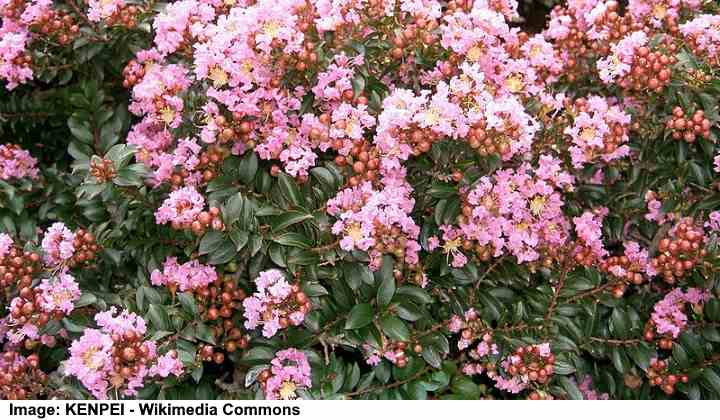
Chickasaw crape myrtle (Lagerstroemia indica x fauriei ‘Chickasaw’) grows up to 2 ft. (0.6 m) tall and has masses of pink flowers
If you want to fill a small garden with stunning pink and red colors, then dwarf crape myrtle shrubs are ideal. Growing 3 to 4 ft. (1 – 1.2 m) tall and wide, these compact shrubs bloom in late summer to autumn with masses of ruffled flowers growing in large clusters.
The attractive feature of crape myrtle bushes is how the pink or red blossoms stand out against the glossy green foliage. The leaves emerge bronze in spring and turn burgundy-red in the fall. Through winter, the shrub holds visual appeal with its grayish-tan bark.
Dwarf crape myrtle shrubs perform best in full sun in USDA zones 6 through 9. Its small growth habit means that the shrub is perfect for small, compact gardens or growing on a balcony or patio in planters.
- USDA Zones: 6 to 9
- Size: 3 to 4 ft. (1 – 1.2 m) tall and wide
- Light Exposure: Full sun
- Soil: Well-drained soil
Garland Flower (Daphne cneorum)
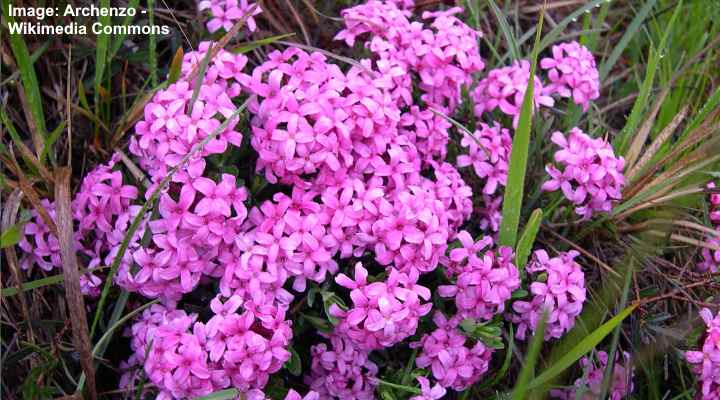
Garland flower is a trailing, low-growing evergreen shrub for partial shade with attractive pink flowers
The garland flower is a stunning, low-growing evergreen shrub that blooms with masses of star-shaped pink flowers in spring. Perfect for growing in small spaces, the small flowering shrub grows 1 ft. (0.3 m) tall and 3 ft. (1 m) wide. The bright pink flowers blossom on long branches covered with narrow, glossy green leaves.
The garland flower is an excellent pink-flowering shrub to introduce a pop of color to beds, borders, pathways, or to complement taller shrubs. In addition, its spreading nature means you can grow the shrub as a flowering ground cover in full sun.
Also called sweet-scented daphne, garland flower performs best in USDA zones 5 through 8 and full sun.
- USDA Zones: 5 to 8
- Size: 1 ft. (0.3 m) tall, 3 ft. (1 m) wide
- Light Exposure: Full sun
- Soil: Moist, well-drained soil
Minuet Mountain Laurel (Kalmia latifolia ‘Minuet’)
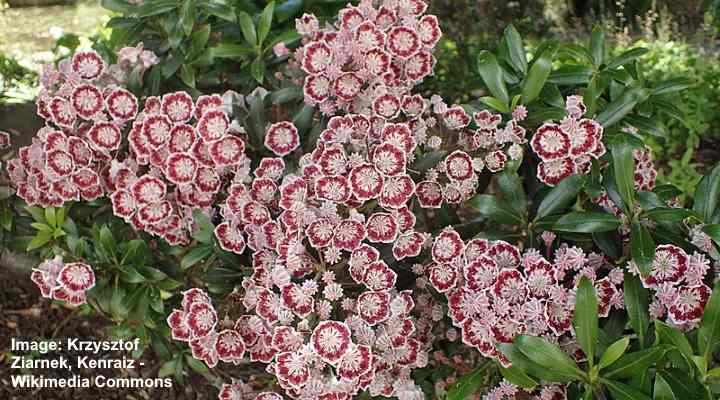
The beautiful mountain laurel ‘Minuet’ is a versatile small flowering shrub that is adaptable to many conditions
‘Minuet’ mountain laurel is an eye-catching evergreen shrub that blooms with red and white bell-shaped flowers. The dense and bushy, rounded shrub has glossy green, leathery leaves. However, the real beauty of the shrub appears in spring and summer when umbrella-shaped clusters of showy flowers cover the shrub.
This dwarf mountain laurel shrub grows 3 ft. (1 m) tall and wide. The flowers are shaped like an open cup with a maroon band around the edges and a star shape in the center. You can plant the shrub along a foundation line, as a shrub border, or in a container on a patio.
Mountain laurel ‘Minuet’ is suitable for growing in USDA zones 4 through 9.
- USDA Zones: 4 to 9
- Size: 3 ft. (1 m) tall and wide
- Light Exposure: Full sun
- Soil: Slightly acidic, moist, well-drained soil
St. John’s Wort (Hypericum x hidcoteense ‘Hidcote’)
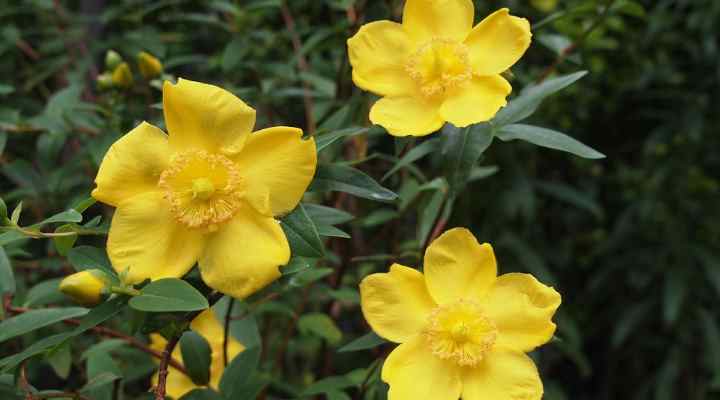
St. John’s wort is an evergreen or semi-evergreen small flowering shrub with attractive yellow flowers
St. John’s wort is a yellow-flowering shrub with golden-yellow blossoms and bushy foliage consisting of narrowly ovate leaves. Only growing around 3 to 5 ft. (1 – 1.5 m) tall and wide, St. John’s wort is an ideal shrub for adding color to a small garden landscape. Use as a colorful hedge, specimen plant, or foundation plant.
St. John’s wort, with its bright golden flowers, looks spectacular when in bloom from early summer through fall. The large yellow flowers measure 3” (7.5 cm) wide, and the star-shaped flowers have a ring of deep yellow stamens in the center.
Grow this miniature rounded shrub in USDA zones 6 through 9 in full to partial sun for best results.
- USDA Zones: 6 to 9
- Size: 3 to 5 ft. (1 – 1.5 m) tall and wide
- Light Exposure: Full to partial sun
- Soil: Moist, well-drained soil
Fuchsia

Fuchsia is a low-growing shrub with attractive flowers in various shades of red, pink, purple, and white
Fuchsias are low-growing shrubby plants that bloom with stunning bell-shaped, drooping red, purple, pink, or white flowers. The small, compact deciduous shrubs are perfect for small gardens in warm climates. The woody shrubs have olive-green foliage, and their flowers dangle from stems.
The most eye-catching feature of fuchsia shrubs is their exotic flowers. Color combinations can be red and purple, red and pink, purple and pink, or red and white. Some varieties have pure white, drooping flowers that contrast nicely with the glossy green foliage.
Fuchsia shrubs grow 1 to 3 ft. (0.3 – 1 m) tall in USDA zones 9 and 10. In cooler regions, the shrubs require winter protection.
- USDA Zones: 9 to 10
- Size: 1 to 3 ft. (0.3 – 1 m) tall
- Light Exposure: Full sun
- Soil: Fertile, well-drained soil
Basil-Leaved Rockrose (Halimium ocymoides)
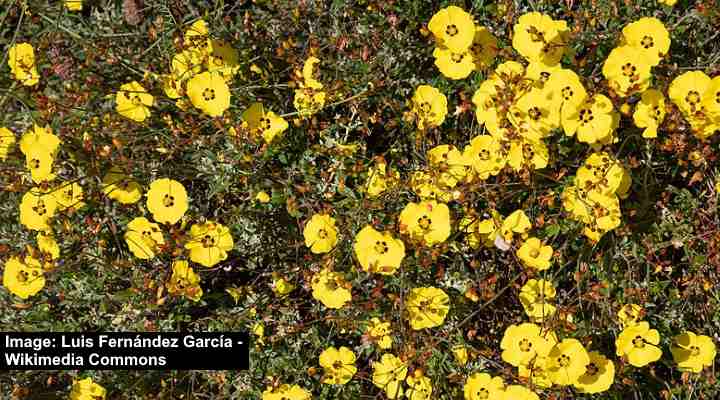
The yellow-flowering basil-leaved rockrose is a dwarf evergreen shrub for full sun
Basil-leaved rockrose is a dwarf, evergreen shrub with eye-catching, five-petaled yellow flowers. The saucer-shaped yellow flowers measure 1.2” (3 cm) and have a contrasting deep purple center. Blooming in late spring and early summer, the bushy shrub also has small evergreen leaves. The sun-loving compact shrub thrives in USDA zones 8 through 10.
Basil-leaved rockrose is perfect if you have a small garden and want to brighten it with yellow flowers. The mounding shrub grows up to 1.6 ft. (0.5 m) tall and 3 ft. (1 m) wide. The yellow-flowering shrub can be planted in flower beds, along borders, on banks and slopes, or in containers.
- USDA Zones: 8 to 10
- Size: 1.6 ft. (0.5 m) tall, 3 ft. (1 m) wide
- Light Exposure: Full sun
- Soil: Well-drained soil
Bush Honeysuckle (Diervilla lonicera)
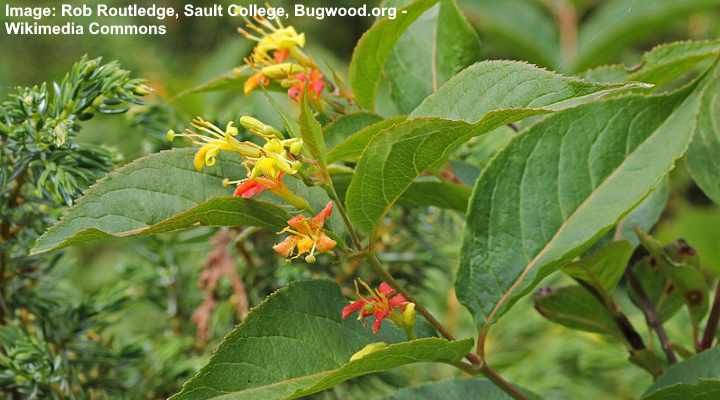
Bush honeysuckle is a small, cold-hardy shrub with yellow and orange flowers
Bush honeysuckle is a small shrubby plant with trumpet-shaped yellow and orange flowers in late spring to early summer. The tubular flowers look like honeysuckle blossoms, growing in small clusters on delicate stems. The yellow flowers contrast with the oblong, pointed, glossy green leaves that turn yellowish-orange in the fall.
Bush honeysuckle grows 2 to 3 ft. (0.6 – 1 m) tall and up to 4 ft. (1.2 m) wide. You can plant this cold-hardy shrub in USDA zones 3 to 7. It’s ideal for growing as a small hedge or shrub border in compact landscapes when space is limited.
- USDA Zones: 3 to 7
- Size: 2 to 3 ft. (0.6 – 1 m) tall, 4 ft. (1.2 m) wide
- Light Exposure: Full sun to partial shade
- Soil: Moist, well-drained soil
Dwarf Flowering Camellia Shrubs
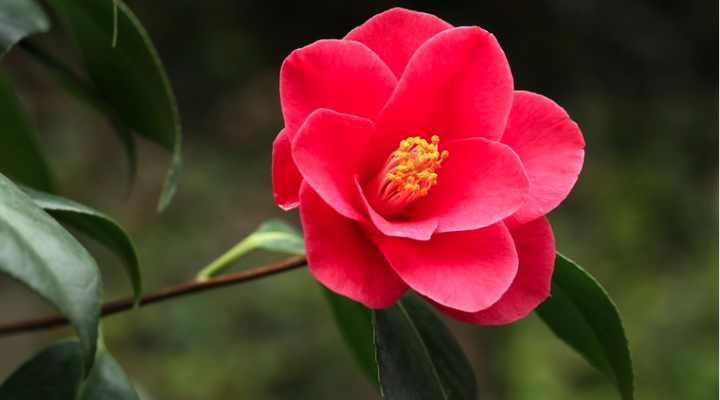
Low-maintenance evergreen camellia shrubs produce red, pink, or white flowers and are suitable for landscaping partially shaded gardens
Dwarf camellia shrubs are perfect for growing in small gardens that have partial to full shade. Camellia shrubs are known for their showy rosette or cup-shaped flowers with semi-double or double blooms. These spectacular flowers bloom on the small shrubs for several months. Low-growing camellia shrubs grow 3 to 5 ft. (1 – 1.5 m) tall.
The two most popular varieties of dwarf camellia shrubs for gardens with limited space are Camellia sasanqua and Camellia japonica. Most varieties thrive in full shade and require little maintenance. In addition, the evergreen foliage and spectacular summer flowers provide outstanding landscaping value.
Dwarf camellia shrubs perform best in USDA zones 7 to 9. Despite being a shade-loving flowering shrub, some compact varieties grow well in full sun if they get enough water during warm summers.
- USDA Zones: 7 to 9
- Size: 3 to 5 ft. (1 – 1.5 m) tall
- Light Exposure: Full sun
- Soil: Organically rich, slightly acidic, well-drained soil
Serviceberry ‘Regent’ (Amelanchier alnifolia ‘Regent’)
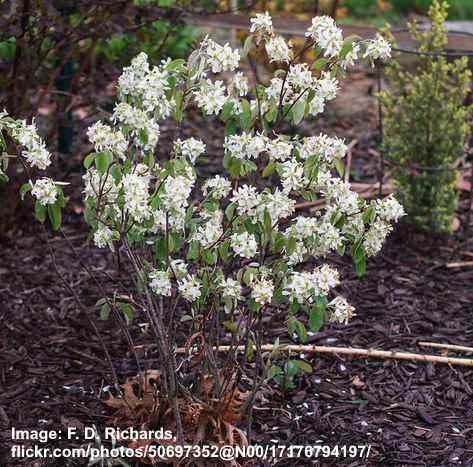
Serviceberry ‘Regent’ is a small flowering shade-loving shrub that is cold-hardy
Serviceberry ‘Regent’ is a compact flowering shrub blooming with masses of fragrant white flowers. The showy flowers grow in clusters and cover the small bush in spring. After blooming, the flowers give way to dark purple berries, and the small green leaves turn burgundy and yellow in the fall.
Cold-hardy serviceberry performs well in USDA zones 2 through 7. The low-growing, compact shrub requires little maintenance to retain its rounded habit. Once established, the ornamental shrub is tolerant of drought and harsh, dry conditions.
Serviceberry ‘Regent’ is ideal for compact landscapes or small yards. You can grow the bushy shrub as a specimen plant, deciduous hedge, foundation plant, or a windbreak.
- USDA Zones: 2 to 7
- Size: 3 to 6 ft. (0.9 – 1.8 m) tall
- Light Exposure: Full sun
- Soil: Moist, well-drained soil
Coastal Doghobble (Leucothoe axillaris)
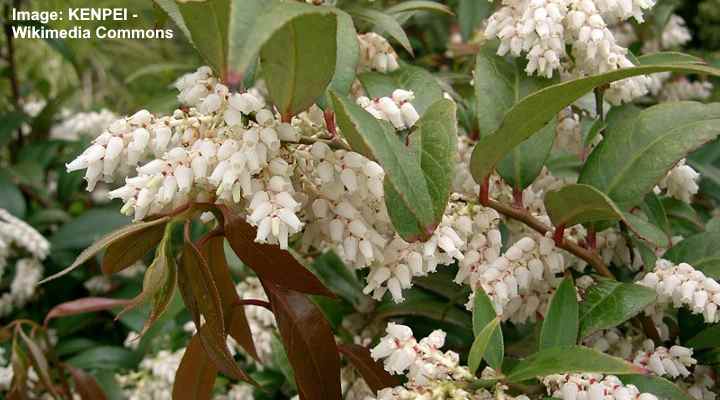
Coastal doghobble has attractive white flowers and is small enough to decorate shaded gardens with limited space
Coastal doghobble is a small flowering shrub that thrives in part shade to deep shade. This shrub is characterized by its cup-shaped, spring-summer blooming, pinkish-white flowers growing in drooping conical clusters. The evergreen shrubby plant has curled, lance-shaped leaves that turn red in the fall and purple in winter.
Coastal doghobble has a year-long landscaping interest for small, shaded gardens. Thriving in USDA zones 5 through 9, the shrub grows 3 to 4 ft. (1 – 1.2 m) tall and 6 ft. (1.8 m) wide. The low-maintenance ornamental shrub is ideal as a front yard foundation plant, specimen plant, or container plant on a small patio.
- USDA Zones: 5 to 9
- Size: 3 to 4 ft. (1 – 1.2 m) tall, 6 ft. (1.8 m) wide
- Light Exposure: Full sun
- Soil: Well-drained soil
Tree Peony (Paeonia suffruticosa)

The tree peony produces beautiful flowers to add a pop of color to partially shaded locations
The tree peony is a small mounding shrub that produces large, showy flowers in mid- to late-spring. Peony flowers are ruffled double blooms in shades of red, pink, white, and multicolored petals. The fragrant, colorful flowers stand out against the lush green foliage, giving the small woody shrub tremendous landscaping value.
Tree peonies are suitable for compact front or backyards in USDA zones 4 through 7. The shrubs perform well in full sun or partial shade. You can grow the flowering shrubs as a specimen plant, to decorate a mixed border, or as a foundation planting.
Tree peony shrubs grow 3 to 5 ft. (1 – 1.5 ft.) tall and up to 4 ft. (1.2 m) wide. These hardy landscaping shrubs don’t require pruning unless the woody stems become leggy.
- USDA Zones: 4 to 7
- Size: 3 to 5 ft. (1 – 1.5 ft.) tall, 4 ft. (1.2 m) wide
- Light Exposure: Full sun to partial shade
- Soil: Fertile, well-drained soil
Creeping Mahonia (Berberis repens)
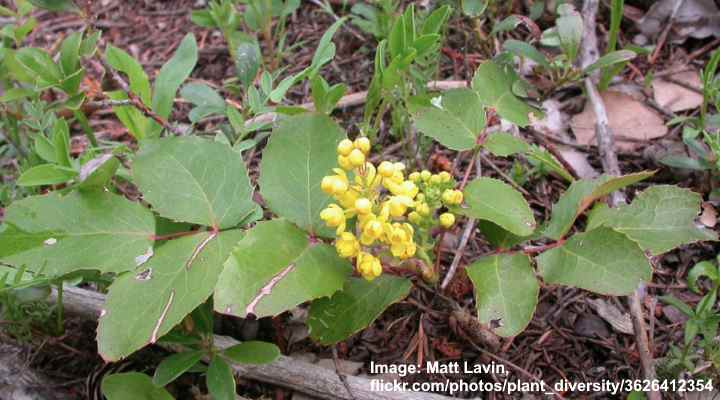
Creeping mahonia is a flowering ground cover shrub with yellow flowers and blue berries
Creeping mahonia is perfect for growing in a small, compact landscape due to its short height and spread. The spring-flowering, evergreen shrub blooms with golden yellow flowers and has year-long bluish-green foliage and clusters of waxy-blue berries. This small broadleaf shrub grows up to 1.5 ft. (0.45 m) tall and 3 ft. (1 m) wide.
Sun-loving creeping mahonia is tolerant of drought and resistant to deer and rabbits. This low-growing shrub is suitable for planting in small gardens in USDA zones 5 to 8.
Creeping mahonia is a perfect small flowering shrub for sunny landscapes. Due to its low growth, you can plant it as ground cover or under larger shrubs. Additionally, the compact shrub grows well in borders and containers.
- USDA Zones: 5 to 8
- Size: 1.5 ft. (0.45 m) tall, 3 ft. (1 m) wide
- Light Exposure: Full sun
- Soil: Rich, well-drained soil
Lydian Broom (Genista lydia)
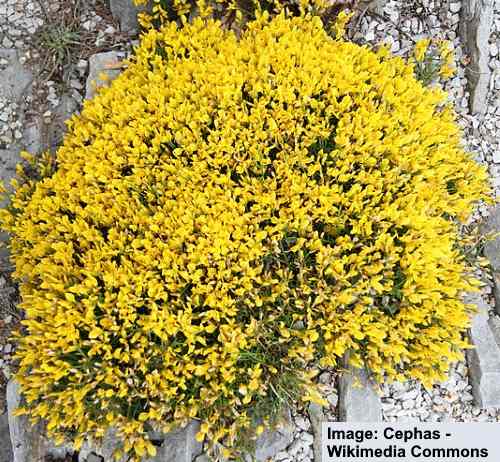
The yellow-flowering Lydian broom is a small shrub for a sunny location in your garden
The Lydian broom is a yellow-flowering deciduous dwarf shrub that blooms with masses of pea-like yellow flowers in spring and early summer. The small mounding shrub has delicate arching stems with small green leaves. It grows 1 to 2 ft. (0.3 – 0.6 m) tall and wide in full sun.
The Lydian broom is ideal for brightening a small front or backyard. The trailing branches look attractive cascading over the edges of containers, hanging baskets, or low walls. Additionally, you can plant the shrub in beds and borders, use it as a bushy ground cover, or plant it along a foundation line.
Lydian broom is suitable for planting in USDA zones 4 through 9.
- USDA Zones: 4 to 9
- Size: 1 to 2 ft. (0.3 – 0.6 m) tall and wide
- Light Exposure: Full sun
- Soil: Well-drained soil
Red-Flowering Chinese Quince (Chaenomeles speciosa)

The thorny Chinese quince bush is a decorative spiky plant with attractive flowers and edible fruit
The Chinese quince is a compact, deciduous shrub with showy, bowl-shaped red flowers. The flowers bloom in spring and consist of five delicate petals arranged in a saucer shape. The shrub has thorny branches covered with oval-shaped, alternate, dark green leaves. It also produces small, round fruits that emerge green and ripen to a yellow tone.
Small clusters of two to four red flowers cover the Chinese quince. These flowers usually measure around 1.6 inches (4 cm) in diameter. As early spring arrives, the shrub transforms into a stunning display of crimson-red colors.
The red-flowering Chinese quince grows 4 to 5 ft. (1.2 – 1.5 m) tall and up to 8 ft. (2.4 m) wide. This attractive shrub can be grown as a deciduous flowering hedge, specimen plant, or foundation plant. It can also be grown against a wall.
Although the quince fruits are edible, they usually have a bitter taste. Because of this, they are usually used to make jellies and preserves.
- USDA zone: 5 to 9
- Size: 4 to 5 ft. (1.2 – 1.5 m) tall, 8 ft. (2.4 m) wide
- Light Exposure: Full sun
- Soil: Well-drained soil
Red-Flowering Climbing Clematis Shrub

Clematis is a common easy to grow climbing plant in many gardens with various shades of flowers including red
Red flowering clematis shrubs are known for their vibrant red, saucer-shaped blooms, deciduous lance-shaped leaves, and compact low-growth habit. The attractive, spring-blooming flowers thrive in full sun. These shrubs usually grow between 3 to 5 ft. (1 – 1.5 m) tall.
Bush-forming clematis plants are well-suited for growing in foundation plantings, perennial borders, or along driveways. Their compact, bushy nature also makes them a great choice for container gardening, where their sweet-smelling blooms can infuse patios and decks with a lovely floral aroma.
Red-flowering clematis plants are usually vines though some varieties have an upright, shrub-like growth habit. Types of shrubby clematis plants include Clematis integrifolia, Clematis heracleifolia, and Clematis hexapetala.
- USDA zone: 4 to 9
- Size: 3 and 5 ft. (1 – 1.5 m) tall
- Light Exposure: Full sun
- Soil: Moist, well-drained soil
Spanish Broom (Genista hispanica)

The Spanish broom is an ornamental, deciduous shrub known for its bright yellow flowers that bloom in spring and summer. Some identifying features of this plant include its plentiful clusters of pea-like flowers, dark green spiky leaves, and dense spreading habit. This sun-loving shrub grows well in poor soils.
The Spanish broom can reach up to 3 ft. (1 m) in height. The yellow shrub is ideal for ground cover, xeric landscaping, or Mediterranean gardens.Additionally, it excels when incorporated into rock gardens, slopes, borders, and as part of front of the house landscaping. Moreover, it serves as an excellent plant for drawing bees and butterflies. Drought-tolerant once established.
- Mature Size: 2 to 3 ft. (0.6 – 1 m) tall and 4 to 5 ft. (1.2 – 1.5 m) wide
- USDA Zone: 7 to 9
- Sun Exposure: Full sun
- Soil Type: Poor, infertile, well-drained soils
Winter Daphne (Daphne Odora ‘Alba’)
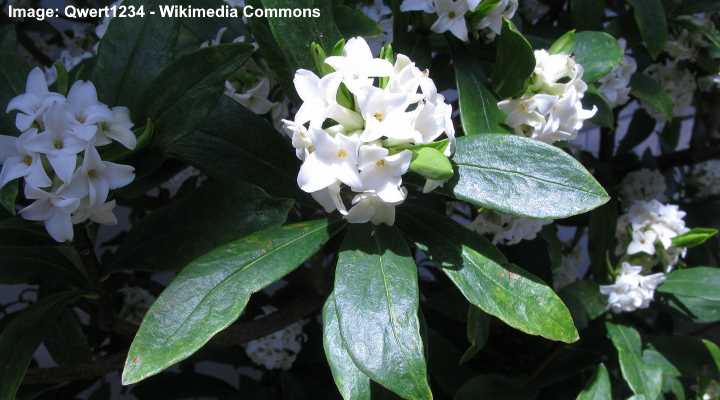
Winter Daphne (Daphne Odora ‘Alba’)
The winter daphne is a compact, rounded shrub characterized by its scentful, creamy white flowers. The shrub’s flowers are arranged in a globular shape and bloom in late winter to early spring. Another appealing characteristic of these perennial evergreen shrubs is the presence of glossy, leathery, pointed oblong leaves, which typically reach a length of 3 inches (7.5 cm).
Another beautiful white flowering cultivar of daphne odora is ‘Aureomarginata Alba’, featuring dark green, shiny leaves with white margins.
- USDA zone: 7 to 9
- Size: 3 and 6 ft. (1 – 1.8 m), 4 ft. (1.2 m) wide
- Light Exposure: Full sun
- Soil: Well-drained, moist soil
Nodding Pincushion (Leucospermum Cordifolium)

The nodding pincushion is an upright evergreen shrub known for its large, yellow to red flower heads that look like pincushions. The shrub also has elliptic, stiff, hairy leaves that are gray-green in color.
The nodding pincushion typically blossoms during the spring and summer seasons. Landscaping ideas include growing as a focal point, specimen plant, or container plant. Additionally, the shrub’s beautiful flowers make it great for cut flower arrangements.
- USDA zone: 9 to 11
- Size: 5 ft. (1.5 m) tall
- Light Exposure: Full sun
- Soil: Well-drained, slightly acidic soil
Hebe x franciscana ‘Blue Gem’
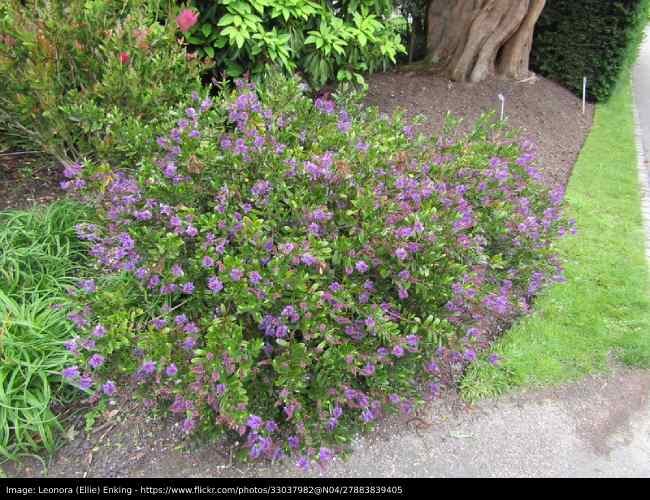
Hebe x franciscana ‘Blue Gem’ is a bushy, evergreen shrub with a spreading growth habit. The shrub is characterized by its attractive purple flowers that almost envelop the shrub. The flowers blooming season lasts from summer until autumn. It also has elliptic to lance-shaped, deep green foliage, beautifully contrasting against the purple blooms. It is drought- and salt-tolerant, as well as capable of withstanding temperatures down to -10°C (14°F). This shrub is best grown as a foundation or specimen plant.
- USDA zone: 8 to 11
- Size: 4.9 ft. (1.5 m)
- Light Exposure: Full sun to partial shade
- Soil: Well-drained soil
Flame of the Woods (Ixora coccinea)
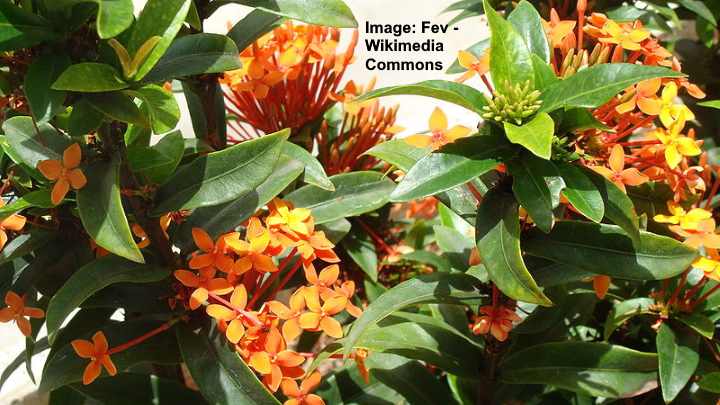
Flame of the Woods (Ixora coccinea)
The flame of the woods is a dense, rounded shrub characterized by its attractive, 4-petaled orange blooms. The spring-blooming, tubular-shaped flowers grow in 5-inch (13 cm) wide, rounded clusters. The broadleaf shrub’s glossy, dark evergreen leaves grow 6 inches (15 cm) long.
The flame of the woods is drought- and heat-tolerant, growing 4 to 6 ft. (1.2 – 1.8 m) tall. The rounded, evergreen bush is a favored choice for sunny Florida yards. The shrub can be grown as an evergreen hedge, screening plant, or foundation plant.
- USDA zone: 10 and 11
- Size: 4 to 6 ft. (1.2 – 1.8 m) tall
- Light Exposure: Full sun
- Soil: Organically rich, well-drained soil
Firebush (Hamelia patens)

Firebush (Hamelia patens)
Also known as the Mexican firecracker, the firebush is known for its rounded clusters of attractive, vibrant orange, tube-shaped flowers. The shrub’s erect stems feature forked clusters of bright orange blossoms at their tips. The flowers range in size from 1 to 1.5 inches (2 to 4 cm), while the pointed evergreen leaves measure 6 inches (15 cm) in length. After the flowers bloom, the shrub gives way to oval-shaped, glossy black berries.
The firebush is often grown as an ornamental shrub, and reaches 2 to 3 ft. (0.6 – 1 m) tall and 2 ft. (0.6 m) wide. Flourishing in full sun and well-drained, moist soils, this orange-flowering shrub is sure to add a touch of beauty to any landscape. The shrub is a great addition to a sunny garden as a screen, hedge, border plant, or foundation plant.
- USDA zone: 10 and 11
- Size: 4 to 6 ft. (1.2 – 1.8 m) tall
- Light Exposure: Full sun
- Soil: Organically rich, well-drained soil
Glossy Abelia (Abelia x grandiflora)
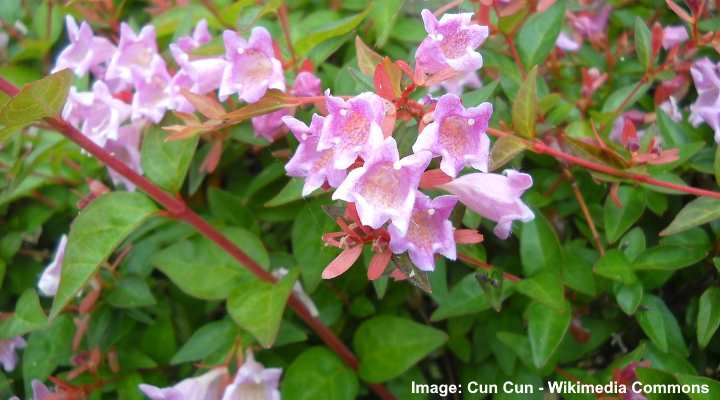
Glossy Abelia (Abelia x grandiflora)
The glossy abelia is a hardy, semi-evergreen shrub that showcases pale-pink flowers. The bushy plant is distinguished by its dense, rounded growth habit, pinkish-white, bell-shaped flowers, and glossy, dark green oval leaves.
In late spring and summer, the glossy abelia bursts into bloom, showcasing abundant star-shaped, fragrant flowers in either white or pink tubular forms. In fall, the foliage turns an attractive purplish-bronze hue, adding beauty to the autumn landscape. This easy-care shrub demands little pruning and becomes drought-tolerant once it’s well-established.
The glossy abelia is suitable for hedges, borders, mass plantings, or as a specimen plant. It’s also a great option for growing in containers in a patio or decking area.
- Mature Size: 3 to 6 ft. (1 – 1.8 m) tall and wide
- USDA Zone: 6 to 9
- Sun Exposure: Full sun to partial shade
- Soil Type: Well-drained soil with medium moisture
Red Bougainvillea Shrub

Bougainvillea is a flowering climbing plant that comes in various colors and thrives in full sun
The bougainvillea is a vining, perennial blooming shrub that produces an abundance of magenta, pink, or red flower-like bracts. The shrub also features alternate, dark green, heart-shaped leaves that grow on thorny woody stems. The shrub also produces tiny flowers that grow in the middle of three vivid red bracts. The shrub can grow 15 to 40 ft. (4.5 – 12 m) wide or tall (if supported).
The bougainvillea has a vine-like growth habit, often climbing over walls or growing over trellises or arbors. Despite this, it can be trained to grow like a regular shrub. The red bougainvillea makes a great privacy screen and pergola plant in a hot summer landscape.
It is also possible to grow bougainvillea shrubs in containers, usually as a small, petite, tree-like flowering shrub.
The vivid hues of red bougainvillea shrubs remain consistent throughout the season because the “blooms” are actually bracts, a form of modified leaves.
- USDA zone: 9 to 11
- Size: 15 to 40 ft. (4.5 – 12 m) wide or tall (if supported)
- Light Exposure: Full sun
- Soil: Sandy, well-drained soil
Chinese Fringe Flower (Loropetalum chinense ‘Ever Red’)
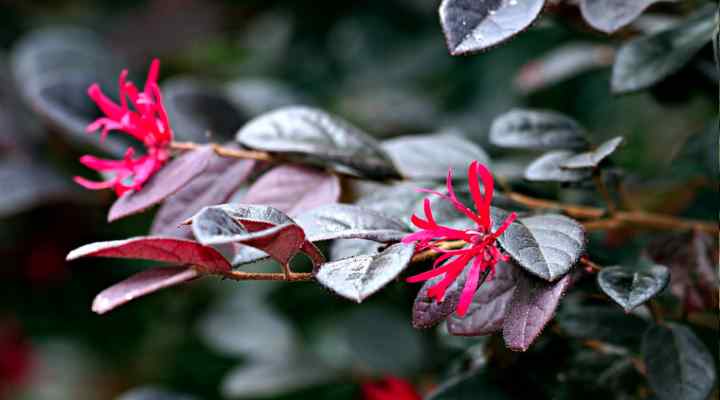
Chinese Fringe Flower (Loropetalum chinense ‘Ever Red’)
The Chinese fringe flower is a bushy, evergreen shrub known for its vivid red, delicate flowers with spindly petals. The shrub has glossy, dark burgundy leaves, which beautifully contrast against the red flowers. The red clusters of flowers begin blooming in late winter and early spring.
The Chinese fringe flower ‘Ever Red’ reaches a maximum height of 6 ft. (1.8 m). This attractive red-flowering shrub can be grown as a specimen or foundation plant in full sun. It can also be grown as a hedge, privacy screen, or container plant.
- USDA zone: 7 to 9
- Size: 6 ft. (1.8 m) tall
- Light Exposure: Full sun
- Soil: Humus-rich, moist, well-drained soil
Oregon Grape Holly (Mahonia aquifolium)
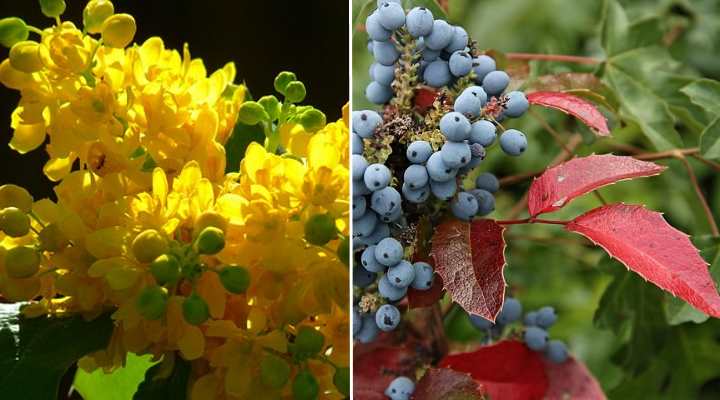
The Oregon grape is a flowering evergreen shrub with yellow flowers in early spring, followed by blue berries, and is small enough for accenting front of house shaded areas
The Oregon grape holly is a low-growing, spreading evergreen shrub with dense clusters of fragrant, small yellow flowers. Other identifying features include its spine-tipped, leathery leaves and dark bluish-black fruits. The shrub’s leaves turn deep burgundy in the fall.
The Oregon grape holly is a slow-growing, hardy, and low-maintenance shrub that is known to attract wildlife, especially birds. Its attractive berries are often consumed by various bird species, making it a popular choice for bird-friendly gardens. Additionally, the plant’s flowers can also attract pollinators such as bees and butterflies.
Thriving in shaded conditions, this yellow flowering shrub excels as a foundation plant, security screen, and hedge. It is also great for planting in rural gardens due to its deer resistance.
- Mature Size: 3 to 6 ft. (1 – 1.8 m) tall and 2 to 5 ft. (0.6 – 1.5 m) wide
- USDA Zone: 5 to 8
- Sun Exposure: Partial shade to full shade
- Soil Type: Organically rich, acidic, moist, well-drained soil
Scotch Broom ‘Moonlight’ (Cytisus scoparius ‘Moonlight’)

The Scotch broom ‘Moonlight’ is a multi-stemmed deciduous shrub featuring small, round, pale-yellow flowers that bloom on arching or upright stems. In spring, the yellow-flowering shrub features a spectacular floral display, showcasing its beauty. Other identifying features include deep green, trifoliate leaves, and hairy seed pods.
The Scotch broom ‘Moonlight’ cultivar grows up to 6 ft. (1.8 m) tall and has a compact growth habit. When it blooms in spring, the profusion of fragrant, nectar-rich yellow flowers draws in bees and butterflies. Landscaping uses for the versatile shrub include growing in beds and borders, coastal gardens, rock gardens, or xeriscapes.
- Mature Size: 5 to 6 ft. (1.5 – 1.8 m) tall and wide
- USDA Zone: 5 to 8
- Sun Exposure: Full sun
- Soil Type: Well-drained, infertile soils
Red Ace Shrubby Cinquefoil (Potentilla fruticosa ‘Red Ace’)
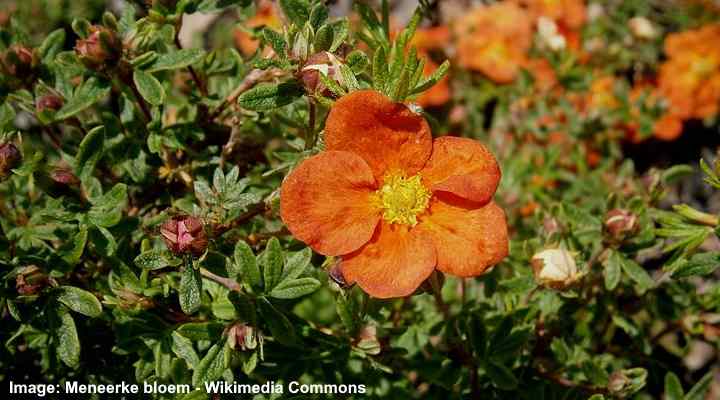
Shrubby Cinquefoil (Potentilla fruticosa ‘Red Ace’)
The red ace shrubby cinquefoil is a bushy, deciduous shrub featuring large, 5-petaled orange blooms with yellow centers. The shrub has a densely branched mounding growth habit. The flowers tend to become more vibrant in hot weather. This small shrubby bush has small, pointy gray-green leaves that contrast nicely with the orange flowers.
The red ace shrubby cinquefoil grows 2 to 3 ft. (0.6 – 1 m) tall and 4 ft. (1.2 m) wide. The shrub is incredibly hardy, capable of tolerating high heat as well as freezing temperatures. It is also drought- and salt-tolerant.
The red ace shrubby cinquefoil looks great when incorporated into sunny borders. Other landscaping ideas include growing as a foundation plant, specimen plant, or informal flowering hedge. The bright orange flowers bloom from late spring and remain until the first frosts early in the winter.
- USDA Zones: 3 to 7
- Size: 2 to 3 ft. (0.6 – 1 m) tall, 4 ft. (1.2 m) wide
- Light Exposure: Full sun
- Soil: Moist, well-drained soil
Abutilon ‘Bella Red’

Abutilon ‘Bella Red’ is a small, tender shrub recognized for its large, bell-shaped red flowers with a yellow-orange center. The beautiful nectar-rich flowers attract pollinators such as hummingbirds and bees. This shrub also showcases evergreen, maple-like leaves that have a light green hue. It is ideal for growing as a specimen plant in the front yard as well as in containers.
- USDA zone: 9 to 10
- Size: 1.4 ft. (0.4 m) tall and wide
- Light Exposure: Full sun to part shade
- Soil: Moist, well-drained soil
Deutzia ‘Strawberry Fields’ (Deutzia x hybrida ‘Strawberry Fields’)

The deutzia ‘Strawberry Fields’ is a compact, deciduous shrub known for its stunning conical clusters of five-petaled, vibrant pink flowers. These fast-growing shrubs feature oval-shaped, deep green leaves and brown seed capsules in autumn. The irregular-shaped shrub reaches 4 to 6 feet (1.2 – 1.8 m) tall and wide.
The deutzia ‘Strawberry Fields’ is tolerant of a wide range of soils as long as they are well-drained. During late spring to early summer, the shrub bursts into bloom, drawing butterflies and bees to garden landscapes. This low-maintenance shrub is ideal for growing as a foundation plant, shrub border, or informal hedge.
- Mature Size: 4 to 6 ft. (1.2 – 1.8 m) tall and wide
- USDA Zone: 5 to 8
- Sun Exposure: Full sun to partial shade
- Soil Type: Medium moisture, well-drained soil with good organic content
Korean Abelia (Abelia mosanensis)

The Korean abelia is a deciduous, upright shrub featuring starry, pinkish-white flowers that bloom in spring. The shrub features oval-shaped, glossy, dark green leaves that grow on arching stems. The shrub grows 3 to 5 ft. (1 – 1.5 m) tall.
The Korean abelia features reddish stems with leaves that turn an attractive orange-red shade in autumn. The low-growing compact shrub is an excellent addition to a shrub border or foundation planting. It can also be grown as an informal pink-flowering hedge.
- Mature Size: 3 to 5 ft. (1 – 1.5 m) tall and 3 to 4 ft. (1 – 1.2 m) wide
- USDA Zone: 4 to 8
- Sun Exposure: Full sun to partial shade
- Soil Type: Well-drained soil
Chinese Plum (Prunus glandulosa)
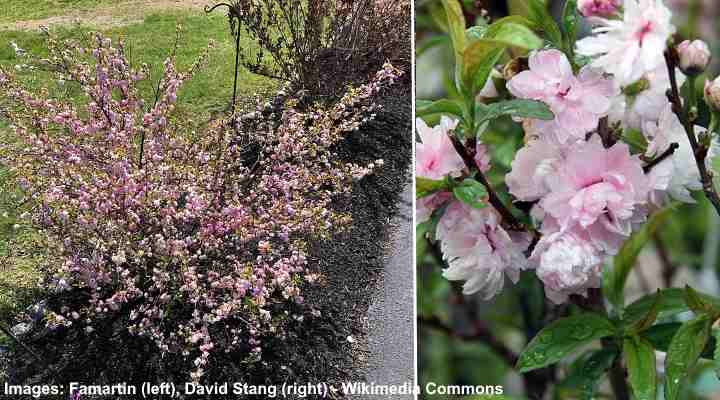
The Chinese plum is a small, multi-stemmed shrub recognized for its beautiful, pink cherry-like flowers. Clusters of pale pink, double flowers cover the stems in early spring. Other identifying features include thin stems that form an irregular shape as well as alternate, mid-green leaves. After the blooming period is over, the tree produces round red fruits.
In early spring, before the leaves emerge, the Chinese plum bursts into bloom, showcasing a breathtaking array of double pink flowers. The dwarf flowering almond tree is primarily employed as an ornamental shrub in both front and backyards, serving as a focal point that enhances the beauty and fragrance of any landscape.
- Mature Size: 4 to 5 ft. (1.2 – 1.5 m)
- USDA Zone: 4 to 8
- Sun Exposure: Full sun to partial shade
- Soil Type: Moist, organically rich, well-drained soils
Related Articles:
